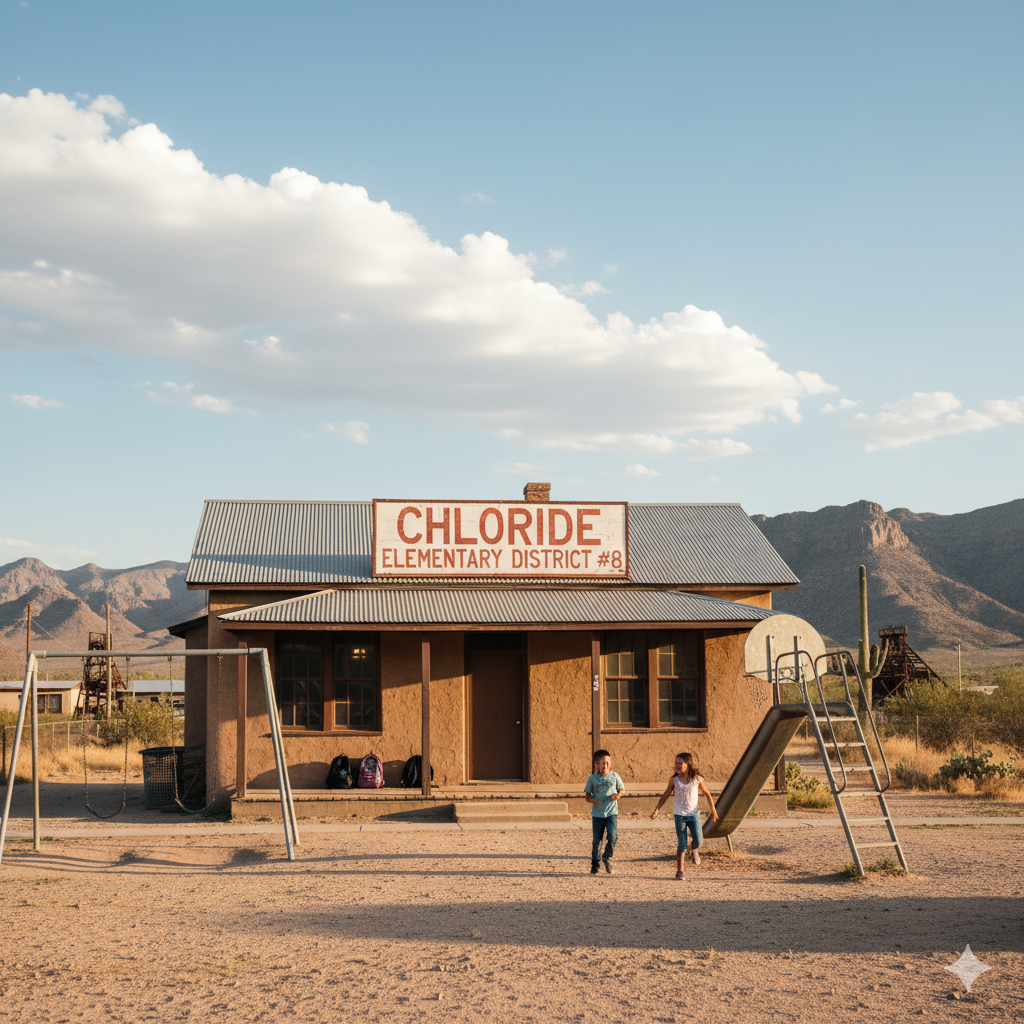In the quiet, rugged landscapes of Mohave County sits Chloride, Arizona—a community with roots stretching back to the silver mining boom of the 1860s. While many mining camps disappeared with the decline of ore production, Chloride has endured as the state’s oldest continuously inhabited mining town. At the center of this perseverance lies its local school system, the Chloride Elementary District—an institution that embodies the history, resilience, and close-knit spirit of the town.
 A District Steeped in History
A District Steeped in History
Chloride was established around 1863, taking its name from the silver chloride deposits fueling the earliest mines. As families settled alongside miners, the need for organized education became clear. This led to the creation of the Chloride Elementary District, officially designated District #8. Unlike many small rural schools in Arizona that were eventually absorbed into larger systems such as the Kingman Unified School District, Chloride’s school has managed to stay autonomous. That independence reflects the town’s pride in local governance and its dedication to providing an education shaped by community values.
 Structure and Grade Levels
Structure and Grade Levels
Chloride Elementary is a traditional K–8 district, focusing exclusively on early and middle grade education before students move on to high school, typically within the Mohave Union High School District in Kingman. Concentrating on these grade levels allows the district to dedicate resources to building strong educational foundations. Students benefit from a consistent learning environment without the transitions urban students often navigate, and teachers can cultivate lasting relationships with families across multiple grades.
 Small Classes, Strong Support
Small Classes, Strong Support
With a modest student body, Chloride Elementary offers one of its greatest advantages: a very low student-to-teacher ratio. Where urban classrooms may have 25–30 children, classes in Chloride are intentionally smaller, enabling more individualized guidance, flexible teaching, and a supportive, family-like atmosphere.
 Curriculum and Innovative Approaches
Curriculum and Innovative Approaches
Although small in size, Chloride Elementary aligns with Arizona’s state learning standards across core subjects: English Language Arts, Mathematics, Science, and Social Studies. However, its approach remains flexible and creative:
Integration of technology: Online learning platforms and digital libraries extend classroom resources.
Partnerships for academic rigor: Programs such as Beyond Textbooks help ensure students meet—and exceed—state benchmarks.
Place-based learning: Lessons often connect with local history or natural surroundings, like the Cerbat Mountains or remnants of old mining camps, offering students a curriculum rooted in their environment.
 A Community Hub in the Desert
A Community Hub in the Desert
In Chloride, the school functions as so much more than an educational institution. It serves as:
A venue for town events, celebrations, and gatherings.
An employer providing jobs for teachers, staff, and support workers.
A guardian of heritage, helping connect students with the town’s historic identity.
For children, recess isn’t just a playground—it can mean running beneath desert foothills or playing within sight of mining landmarks, experiences entirely unique to rural Arizona.
 Governance and Involvement
Governance and Involvement
Leadership of the district falls to a locally elected Governing Board, which drafts budgets, policies, and goals tailored to community needs. In such a small setting, parents and board members are often neighbors, ensuring true grassroots oversight.
Families and residents can support the district in multiple ways:
Volunteering with activities and classroom assistance.
Offering donations for technology, athletics, or general supplies.
Working with county and state officials to advocate for equitable funding, supported by resources from the Arizona Department of Education.
❓Frequently Asked Questions
Q1: What grade levels does Chloride Elementary District cover?
A: The district serves students from Kindergarten through 8th grade. High school students continue within the Mohave Union High School District.
Q2: How many students attend Chloride Elementary?
A: Enrollment is very small, matching the local community’s size. This creates smaller classrooms and highly individualized attention.
Q3: What makes Chloride Elementary unique?
A: Unlike most Arizona schools that have consolidated into larger districts, Chloride has remained independent, offering a community-focused, heritage-rich educational experience.
Q4: Where can I find official information on Arizona schools?
A: The Arizona Department of Education provides detailed resources on school districts, policies, and statewide academic standards.
 Conclusion
Conclusion
Chloride Elementary District continues to be far more than just a school—it is the heart of a historic community, blending tradition with modern education. By providing a personalized K–8 experience, honoring the area’s mining heritage, and maintaining independence in a landscape of consolidation, the district stands as a unique model of community-centered learning in rural Arizona.

